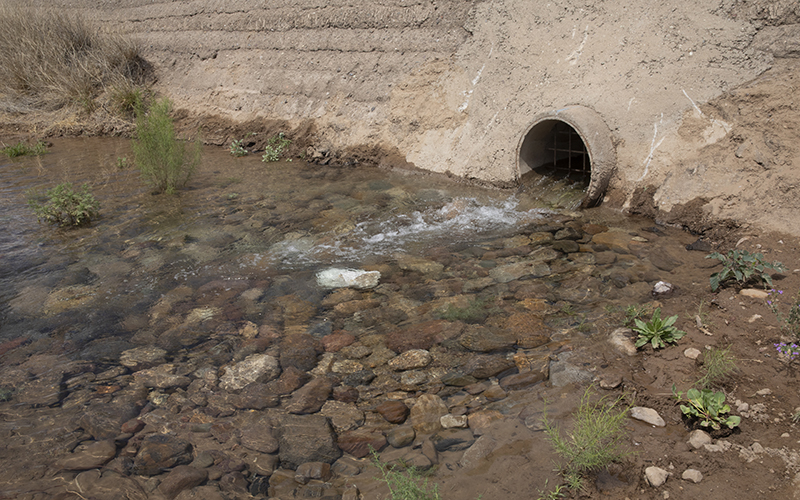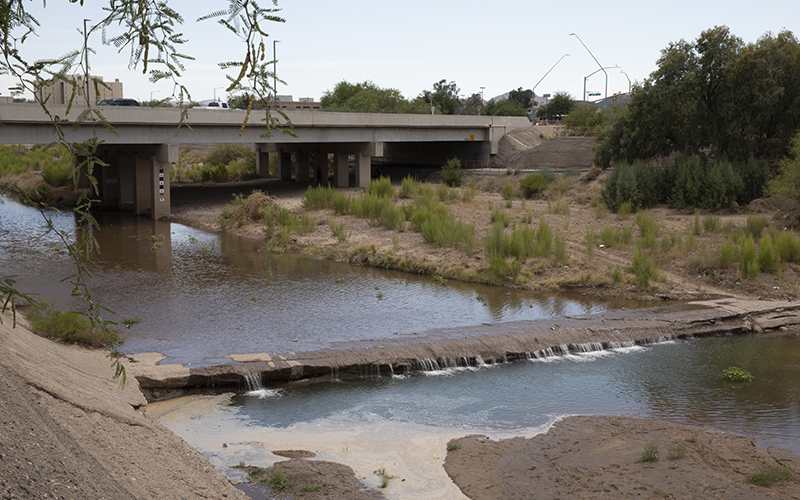TUCSON – Along a parched riverbed where only dust and wild grasses have held sway for the past 70 years, the Santa Cruz now flows again.
As of June 24, under the watch of Tucson Water Department officials, a section of the river just west of downtown will receive a maximum of 2.8 million gallons a day of treated effluent to restore the riparian area and help replenish aquifers as part of the Santa Cruz River Heritage Project.
Last weekend, the water flow stretched almost 2.5 miles, far surpassing the city’s expectations. To reduce this excess, Fernando Molina, a spokesman with Tucson Water, said the city lowered the flow Monday, and the water has since receded to about 1 mile in length.
The goal is to keep the river flowing north just past Congress Street, about a half mile south of its current stopping point near Speedway Boulevard, he said.
Tucson Water director Tim Thomure said the water was available because the city has over-prepared for expected growth and advances have been made in conservation technology and awareness.
“As of 2016, and it’s still true today, we were using the same amount of potable water in Tucson as we were in the mid-1980s, with 200,000 more people and a much more robust economy,” he said. “Because water conservation and efficiency was actually moving faster than new-growth demand for water.”
Most effluent enters Arizona rivers as a means of disposal, Thomure said, but the Heritage Project’s approach of using reclaimed water to restore an ecosystem is the first of its kind in the state.
He called the river the “birthplace of Tucson,” saying the project will honor the river’s rich history and connected culture.
Humans have used the Santa Cruz since about 1,200 B.C., according to the city’s Heritage Project history page. First used by the Hohokam for drinking water, irrigation and fishing, the river was quickly depleted in the late 1800s when settlers began pumping groundwater.
Dan Stormont, with Sustainable Tucson, a volunteer group, called the project an exciting effort by the city but said it’s not a solution on its own.
“It’s just a Band-Aid, honestly,” he said. “It’s a way to restore the natural flow to a small section of the river and make it look the way it used to look – and that’s going to be a challenge, too, because of course it’s not just a river anymore, it’s also a flood control channel.”
Some concerns have been raised about the project, including an increased threat of floods during monsoon season, the potential toxicity of effluent and doubts over whether some of the predicted positive effects – such as increased tourism – will actually materialize.
Thomure acknowledged the decision to restore a section of the Santa Cruz was made quickly, and that only time will reveal whether these concerns are valid.
The city was required to study the reclaimed water’s quality and quantity, as well as how it would interact with existing groundwater stores, before the project was allowed to move forward, he said. The new water, Thomure said, is just as safe as – if not safer than – the natural river water.
Stormont noted concerns about the water’s safety but said it’s likely safer than some water that already enters the river.
“When you consider anytime it rains, we get a large rain, it’s washing all the hydrocarbons off the street, the heavy metals for brake pads, all of that stuff is running into the rivers and being infiltrated as well,” he said. “The effluent that’s being discharged is much cleaner than most of the runoff from the street.”
However, the effluent being pumped into the Santa Cruz River isn’t 100% purified, Thomure said, because city officials feared that “over-engineered” water would not promote the most natural ecological growth possible. He advised visitors to avoid swimming or drinking the river water.

Rat and Zinnia, owned by Deandra Binder and Whitney Noel of Tucson, respectively, enjoy their new place to play at a recently awakened section of the Santa Cruz River. (Photo by Deandra Binder)
Whitney Noel and Deandra Binder of Tucson, who took their dogs for a walk along the riverbed at the mouth of the revived portion, said they’d like the city to make the waterfront more accessible to visitors.
“I think it’s going to bring tons of people out,” Noel said. “There’s no water down here. Even the spots out at Tanque Verde Falls, different areas that we go to … just to get to water in the summertime.”
Thomure said if the project receives continued public support and proves to be sustainable, the city would be open to enacting similar projects farther down the river. This section, at least, is here to stay.
“We expect the water to be discharged to the river indefinitely,” Thomure said. “There will be times where we turn off the flow to maintain the system. There’ll also be times when we turn off the flow when monsoon rains are actually happening and we have natural flows, but this will be a flowing stream from here on out.”
Noel said she hopes the increased river flow instills a sense of pride in Tucson residents and visitors.
“I think a lot of people are going to take pride in it and hopefully keep it really clean,” Noel said. “I would totally volunteer to come down here and clean it up.”
Stormont said this project may be a stepping stone toward further habitat restoration efforts in Tucson.
“It’s not the answer to all our problems, but it is an exciting project that I think does give people some motivation to see what our rivers could look like if we are more careful in how we manage our water,” he said. “Hopefully it’s the first step towards restoring the flow of our rivers in Tucson.”
This story is part of Elemental: Covering Sustainability, a new multimedia collaboration between Cronkite News, Arizona PBS, KJZZ, KPCC, Rocky Mountain PBS and PBS SoCal.
AlertMe


